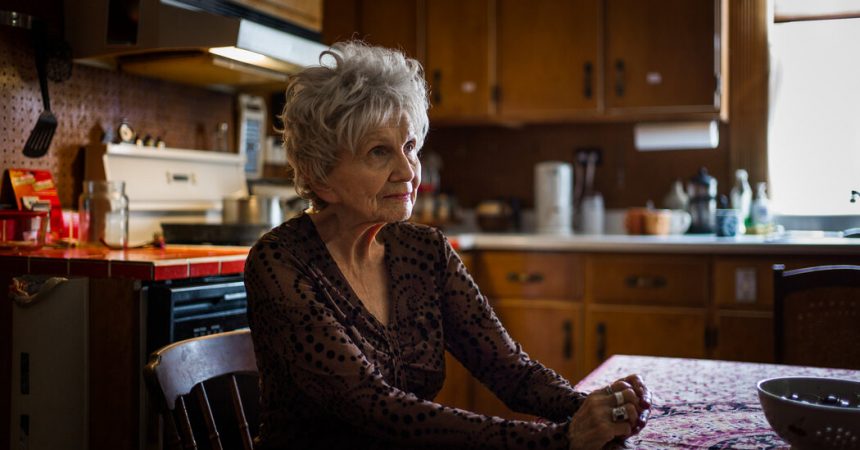In his elegant obituary of Alice Munro, the Nobel laureate who died this week in Port Hope, Ontario, Anthony DePalma writes that her stories “were widely considered to be without equal, a mixture of ordinary people and extraordinary themes.”
Mr. DePalma, a former Toronto bureau chief for The Times, continued: “She portrayed small-town folks, often in rural southwestern Ontario, facing situations that made the fantastic seem an everyday occurrence. Some of her characters were fleshed out so completely through generations and across continents that readers reached a level of intimacy with them that usually comes only with a full-length novel.”
[Read: Alice Munro, Nobel Laureate and Master of the Short Story, Dies at 92]
Ms. Munro and her work have long been covered by The Times. The first reference was one line in 1973 noting the publication of “Dance of the Happy Shades,” a collection of stories that had been released in Canada five years earlier.
This week, Opinion published an essay about Ms. Munro by the Toronto-based novelist Sheila Heti, and Books reminded readers of its guide to Ms. Munro’s work that it first published a few months ago.
[Read: I Don’t Write Like Alice Munro, but I Want to Live Like Her]
[Read: The Essential Alice Munro]
As is often the case when important cultural figures die, The Times also offered “an appraisal” of the work.
[Read: Alice Munro, a Literary Alchemist Who Made Great Fiction From Humble Lives]
Ms. Munro’s appraisal was written by Gregory Cowles, a senior editor at The New York Times Book Review. We spoke about her life and writing. Our conversation has been edited for space and clarity.
When did you begin reading Alice Munro?
I’m sure it was in the pages of The New Yorker because my parents subscribed. But I started reading it more seriously as a high school student. It spoke to me, and I went and sought out her books.
When my wife and I were out on our first date, I knew she’d been an English major. I said, “Oh, who do you read?” And she said, “Well, I wrote my thesis on Alice Munro.” I said, “Ah, my favorite.” Alice Munro brought us together.
As an American, do you find her stories give you a sense of Canada?
Insofar as the settings are almost exclusively Canadian, sure. But for her, the work is so specific to this one region of Canada that you have to ask: Is that particularly representative of Canada as a whole?
In some ways it also feels as much Midwestern American as Midwestern Canadian. Some of the stories cross the border, driving into Michigan or the northern Midwest of America. And so it feels very particular. It’s got a very strong sense of place. But not necessarily a strong sense of national identity.
I’d say it feels more rural in terms of the sensibility. It’s got a very strong sensibility and a very strong sense of place. But I wouldn’t only associate it with Canada.
I must confess that I’ve not read very much of her work. What are people like me missing?
Since my piece appeared, most of the comments are from people who are just huge fans of her work. But sprinkled in there is someone who says “I never quite got it,” “It seemed very flat to me,” or “Nothing happened.”
In my piece, I make a point of saying that in fact quite a lot happens. Not only in an interior sense, as you might expect from short stories. But there are a lot of actual incidents in her stories, too. They’re very rich with plot.
As her career went on, time and memory became very elastic in her stories. What you’re missing in not submitting yourself to her work is the richness of that exploration of how memory works and how we question our own experiences. That felt like an innovation that she brought to short fiction.
She was inventing something. And she was applying some things that novelists had been doing at novel length with time and with memory. But doing it in such a compressed form.
Did she change the perception of short stories generally?
The perception of short stories generally did change while she was at the forefront of the form. But did she change it?
There were a lot of people at her time. If you’re going to talk Canadians: Mavis Gallant. There was like a real revival of the short story. She had something to do with it, for sure. But I think it was also something in the zeitgeist.
What book would you recommend to someone who doesn’t know her work?
She was prolific. I would, of course, say read it all.
But if you want me to say just one, I’d say “Runaway.”
Trans Canada
-
An out-of-control forest fire has again forced some residents of Fort McMurray, Alberta, to evacuate. Among the 6,000 evacuees are people who lost their homes during the enormous 2016 fire there, which remains the most costly natural disaster in Canadian history. And smoke from the first wildfires of the season in Western Canada led to air quality warnings in Minnesota and parts of Wisconsin.
-
After nearly 50 years, the Royal Canadian Mounted Police have linked a fugitive from the United States to the murders of four women whose bodies were dumped in and around Calgary in 1976 and 1977. Investigators believe that the man, who was also a serial rapist, might have killed other women in Canada and the United States. He died in an American prison in 2011.
-
Barbara Hannigan, the singer and conductor from Waverley, Nova Scotia, who is known for doing both from the podium, will become the chief conductor and artistic director of the Iceland Symphony Orchestra.
-
Designers from Canadian Indigenous communities participated in Native Fashion Week in Sante Fe, N.M.
-
Avril Lavigne, the singer who was raised in Napanee, Ontario, is back with a new album and a tour. During an interview, she assured Claire Moses that she most definitely did not die more than 20 years ago to be replaced by a body double.
-
Lyndon Cormack, a founder of the backpack maker Herschel Supply Co., has an unusual guesthouse at his home in North Vancouver: a 31-foot Spartan Spartanette travel trailer from 1953.
A native of Windsor, Ontario, Ian Austen was educated in Toronto, lives in Ottawa and has reported about Canada for The New York Times for two decades. Follow him on Bluesky: @ianausten.bsky.social
How are we doing?
We’re eager to have your thoughts about this newsletter and events in Canada in general. Please send them to nytcanada@nytimes.com.
Like this email?
Forward it to your friends, and let them know they can sign up here.






